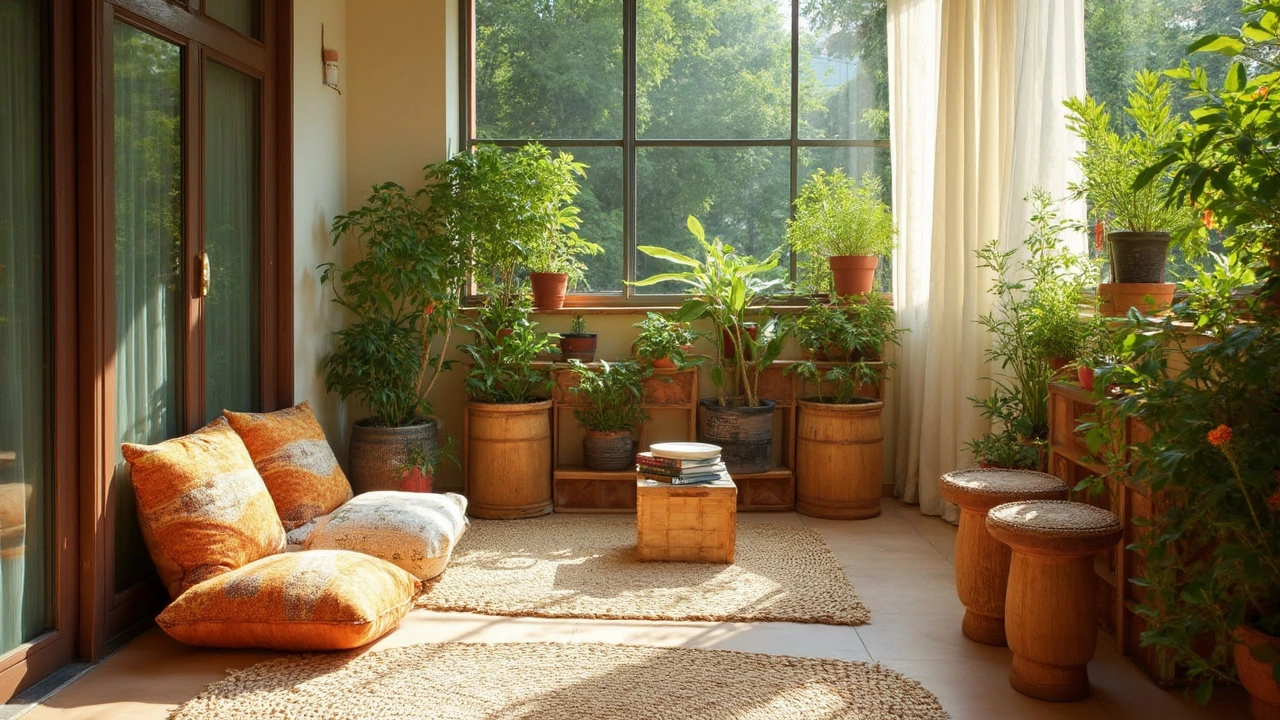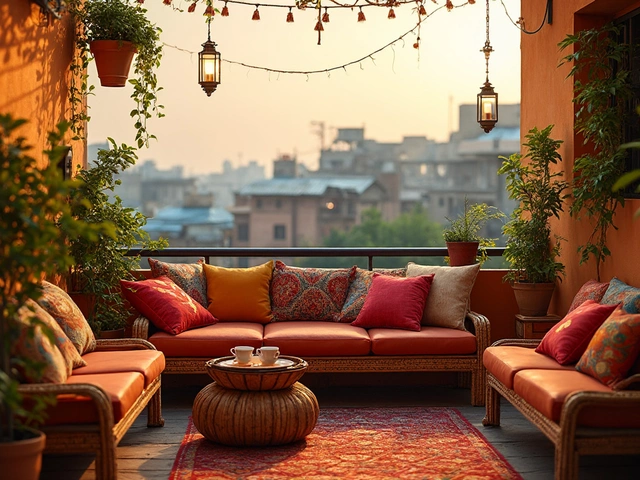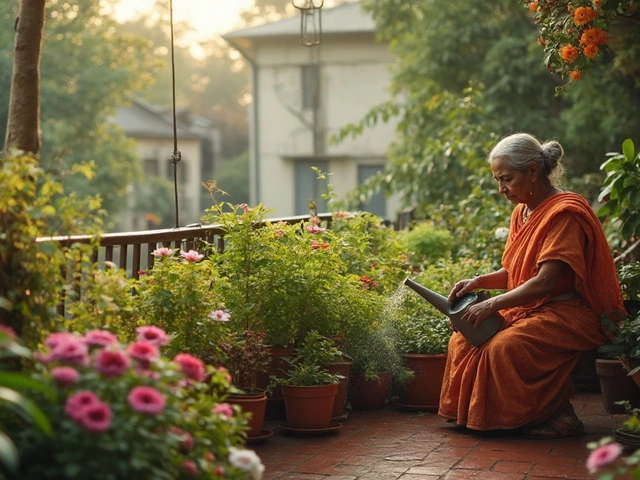Got a balcony that's more storage dump than outdoor chill spot? You can flip it around fast with a few smart moves. Start by figuring out what you actually have to work with—how much sunlight hits through the day, how big the floor space is, and what you'd love to do out there. Knowing this stuff means you won't waste money on plants that croak or seats you'll never use.
A lot of folks squeeze tiny veggies, flowers, or comfy chairs onto the smallest balconies. The trick is to pick just a couple of priorities—like a place to sip coffee or a patch of green you can actually manage. That way, everything you add earns its spot and nothing feels messy.
- Sizing Up Your Space and Sunlight
- Choosing Balcony Plants that Actually Survive
- Budget-Friendly Decor and Furniture Ideas
- Color and Lighting Tricks That Make a Difference
- Clever Ways to Maximize Small Areas
- Easy Maintenance for a Grown-Up Vibe
Sizing Up Your Space and Sunlight
Before you buy anything, you’ve got to really look at your balcony. Some balconies feel tight, others have awkward corners, and most have way less floor space than you wish. Break out a tape measure and jot down the basic length and width. This makes shopping for things like chairs and planters a breeze—and helps avoid returns.
Sunlight is huge for any balcony garden. Not all balconies get the same light. Some get blasted for six hours straight (full sun), others only get an hour or two, and a bunch are mostly shaded by buildings above. Stand on your balcony a few times during the day and check what parts get sun and when. Morning sunlight is gentler, while hot afternoon sun can fry delicate plants or fade cheap furniture fast.
- If you get less than three hours of sun, look for "shade" or "low light" on plant tags.
- Three to six hours? Go with "partial sun" options. They'll do just fine.
- Six or more hours? You can grow pretty much anything meant for "full sun." Even tomatoes or strawberries!
Also, check the wind. High up? Your balcony might be windy, which dries out balcony plants faster and can even knock them over. Heavier pots or low-to-the-ground planters help stop flying dirt and headaches.
| Balcony Feature | What to Check |
|---|---|
| Sunlight Hours | 1-3 (shade), 3-6 (partial sun), 6+ (full sun) |
| Wind Exposure | Loose pots blow over fast; steady wind means plants dry out quickly |
| Floor Size | Measure before buying furniture or planters |
Just doing these quick checks makes the rest of your balcony garden setup way easier. Your space is unique—pick stuff that actually fits it, and you’ll avoid most rookie problems.
Choosing Balcony Plants that Actually Survive
Picking the right balcony plants isn’t about grabbing the prettiest thing at the garden store. You need plants that fit your setup—mainly sunlight, space, and how much effort you’re ready to put in.
Check how much direct light your balcony gets. South-facing spots sizzle in the sun and are great for heat-lovers like succulents, geraniums, or cherry tomatoes. North-facing? You’ll want shade-friendly options, like ferns or peace lilies. East and west get morning or afternoon sun, so you can mix things up with hardy herbs (think mint, basil, or chives).
| Light Level | Great Plant Choices |
|---|---|
| Full Sun (6+ hrs) | Lavender, succulents, petunias, tomatoes |
| Part Sun (3-6 hrs) | Herbs, begonias, peppers, impatiens |
| Shade (<3 hrs) | Ferns, peace lily, snake plant, mint |
If you're the forgetful type, pick hardy plants. Snake plants, pothos, or jade plants are almost impossible to kill and don’t need daily watering. Herbs like oregano or thyme don’t mind if you skip a day or two, either. For flower fans, geraniums are really forgiving — and they keep blooming with minimal drama.
Short on floor space? Think up, not out. Hanging baskets, vertical stands, and railing planters fit more greenery in small spots. Window boxes aren’t just for windows—they work great on balcony rails, giving you a little garden without taking over your chill zone.
One more thing—check your local weather before you splurge on plants. If your city gets cold winds or sudden storms, go for tougher plants or set up lightweight pots you can move inside when it gets wild out there. Balcony gardening is way more fun when your plants don’t bail after the first weather surprise.
Budget-Friendly Decor and Furniture Ideas
You don’t need fancy brands or custom pieces to nail a great look for your balcony garden. Seriously, your local hardware shop or online marketplaces have everything you need. Think basics: stuff that’s weatherproof (so it doesn’t fall apart in the rain) and folds up or stacks away when space is tight.
Start with seating. Folding chairs, small benches, and stackable stools do the trick—they’re usually easy to find on a budget, and you can bring them inside when you need to. A crate with a seat pad can work as a table or an extra perch. If you’re hunting deals, thrift stores and online classified ads often have outdoor furniture for much less than big retailers.
Textiles go a long way. Outdoor rugs change up the vibe fast and feel nicer underfoot. Grab some weather-resistant cushions or covers to add color (bonus: they cover up tired-looking seats). For the real DIY crowd, old pallets make solid benches—just sand them down and toss on a cushion.
- Plastic pots from discount shops are cheaper than ceramic and easier to move.
- Fairy lights or solar lanterns from dollar stores give that cozy glow after sunset.
- Compact foldable tables can double as plant stands or coffee spots.
- Hang planters on the railing instead of cluttering the floor.
Here’s something most people forget: vertical storage. A cheap metal rack or wire shelf can turn an empty wall into a spot for herbs, tools, or decorations. Command hooks even let you hang stuff without drilling.
If you want hard numbers, a study from Statista in 2023 showed that most people spent around $50-100 setting up their first balcony garden. That covered basics like seats, pots, and lights—less than a night out with friends.
| Item | Average Price (USD) |
|---|---|
| Folding Chair | 20 |
| Outdoor Cushion | 10 |
| Plastic Planter | 5 |
| Fairy Lights | 8 |
Bottom line: focus on a few pieces that do double-duty and last through weather swings. Skip fussy stuff and splurge on a seat that’s actually comfy—you’ll use your balcony way more.

Color and Lighting Tricks That Make a Difference
If you want your balcony garden to stand out, color and lighting do most of the heavy lifting. Don’t get hung up on complicated color theory—just stick with a simple palette you actually like. Light colors make your balcony feel bigger. White, pale blue, and soft green for walls or floor tiles bounce light around, so even a cramped or shady spot will seem brighter.
Add pops of brighter color with planters, cushions, or a small outdoor rug. Too many busy patterns, though, can crowd the place, especially on a small balcony. A few bold accents look more stylish and less hectic. If you love flowers, go for plants known for their punch—think geraniums, petunias, or marigolds.
Lighting matters way more than you’d think. Lots of people skip it and miss out. The easiest option is string lights—classic and practically made for decorating balcony spaces. Drape them along the railing, around planters, or across the ceiling. Solar-powered string lights cut down on wiring drama and charge all day, so you don’t stress about outlets.
Lanterns or battery-powered candles can make even an average night feel special. Just avoid anything that drips wax or tips over easily. If you want a table for evening snacks or drinks, tuck in a small LED lamp or tea light for extra glow. Here’s a quick breakdown of common balcony lighting picks:
| Lighting Type | Pros | Cons |
|---|---|---|
| Solar string lights | Easy, no cords, charges daily | Needs direct sunlight to charge |
| Battery lanterns | Portable, safe | Needs new batteries now and then |
| LED tea lights | Candle vibe, safe | Not much light for bigger balconies |
The right color and lighting make your outdoor space way more inviting, and honestly, you don’t need fancy gear. Next time you see your balcony after dark and feel like you’re in a cool little café, you’ll know why you bothered.
Clever Ways to Maximize Small Areas
Even the tiniest balcony can feel big if you use space right. This is where you need to get a bit creative, but it’s not hard. Focus on a couple smart choices and you’ll see a huge difference fast.
- Balcony garden shelves work wonders. Grab tiered plant stands or hang shelves on the railing to stack herbs, flowers, or veggies up instead of out. Some people even use old wooden crates stacked on each other for a DIY option.
- Wall space is gold. Try wall planters, pocket organizers, or hooks for tools and small pots. You can hang lightweight decor or tiny lights, too. Every balcony has more vertical space than you think.
- Collapsible furniture is a gamechanger. Foldable chairs, tables, or little benches mean you can open things up or tuck them away as needed. There are compact bistro sets made just for small balcony tips—look for ones that store easily.
- Use your railing. There are railing planters that clip right on for flowers or sturdy herbs. Some have built-in water reservoirs, which really helps if you forget to water sometimes!
Think about the floor, too. Stackable stools double as tables or plant stands. An outdoor rug helps zone your space and makes it feel finished, no matter how tiny it is.
| Item | Max Space Saved |
|---|---|
| Vertical plant wall | Up to 6 sq. ft |
| Foldable chairs/table | About 2-3 sq. ft each |
| Rail planters | Leaves floor space 100% open |
One last tip—don’t overstuff. If you crowd everything in, your balcony won’t feel relaxing. Stick to a handful of strong decor picks from your main balcony garden plan, and clear out anything that’s just getting in the way. You’ll be surprised how roomy and stylish your outdoor spot turns out!
Easy Maintenance for a Grown-Up Vibe
Let’s be honest, if taking care of your balcony garden turns into another weekend job, it's not going to last. The secret? Pick stuff you can keep up with—even if you sometimes forget to water or sweep. A grown-up vibe isn’t about fussy details; it’s everything looking tidy and intentional without you having to babysit it every day.
First things first: go for balcony plants that don’t need constant attention. Think snake plants, pothos, succulents, or hardy herbs like rosemary. These are famous for thriving with just a splash of water each week. If your space gets a lot of sun, add lavender or marigolds—they look good and can handle heat.
- Use large pots or planters so your plants don’t dry out as fast. Self-watering pots are a game changer.
- Choose outdoor rugs and cushions that can handle sun and rain—think polyester or plastic weaving. Just hose them down if they get dirty.
- If leaves or dust keep piling up, grab a handheld vacuum or a small broom. Takes five minutes. Done.
Don’t forget your furniture. Metal or treated wood lasts much longer outside than cheap plastic, and you won’t end up chasing pieces after a windy day. You can keep it looking fresh by wiping it down once a month with a little soapy water.
| Plant | Sunlight Needs | Watering |
|---|---|---|
| Pothos | Low–medium | Once weekly |
| Succulents | High | Every 10–14 days |
| Lavender | Full sun | Once weekly |
| Snake Plant | Low–medium | Bi-weekly |
Here’s a funny stat: in a 2023 survey, 63% of city dwellers said they gave up on their outdoor space because it got too cluttered or 'too much work.' So, keep only what you really love out there, and skip extra decorations and nicknacks that just gather dust. That way, your balcony stays fresh, grown-up, and so easy to keep nice—even on your laziest day.




